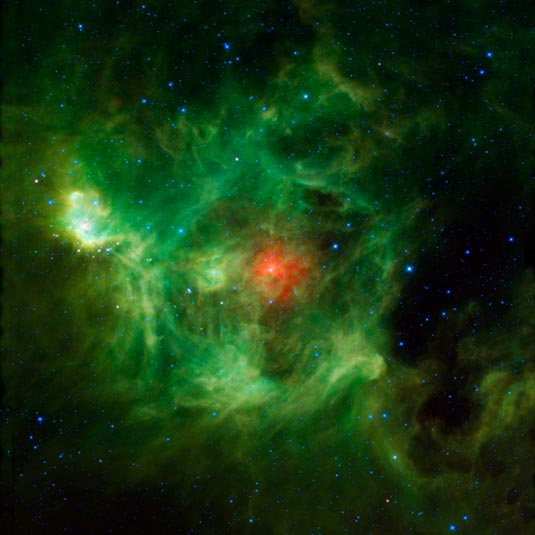
Description: Emission Nebula
Postion (J2000): RA 03h 39.93m Dec +31° 55.55'
Constellation: Perseus
Distance: About 1,000 light-years
Size: About 22 light-years (ring diameter)
Field of View: 1.63 x 1.83 degrees
Orientation: North is straight up
Image Credit: NASA/JPL-Caltech/WISE Team
Release Date: December 22, 2011
ABOUT THIS IMAGE:
In keeping with the spirit of the holidays, NASA's Wide-field Infrared Survey Explorer (WISE) mission presents the "Wreath Nebula". Though this isn't the nebula's official name (it's actually called Barnard 3 or IRAS Ring G159.6-18.5), it's easy to picture a wreath in these bright green and red dust clouds -- a ring of evergreens donned with a festive red bow, a jaunty sprig of holly, and silver bells throughout. Interstellar clouds like these are stellar nurseries, places where baby stars are being born.
The green ring (evergreen) is made of tiny particles of warm dust whose composition is very similar to smog found here on Earth. The red cloud (bow) in the middle is probably made of dust that is more metallic and cooler than the surrounding regions. The bright star in the middle of the red cloud, called HD 278942, is so luminous that it is likely what is causing most of the surrounding ring to glow. In fact its powerful stellar winds are what cleared out the surrounding warm dust and created the ring-shaped feature in the first place. The bright greenish-yellow region left of center (holly) is similar to the ring, though more dense. The bluish-white stars (silver bells) scattered throughout are stars located both in front of, and behind, the nebula.
Regions similar to the "Wreath nebula" are found near the band of the Milky Way in the night sky. The wreath is slightly off of this band, near the boundary between the constellations of Perseus and Taurus, but at a relatively close distance of only about 1,000 light-years, the cloud is a still part of our Milky Way galaxy.
The colors used in this image represent specific wavelengths of infrared light. Blue and cyan (blue-green) represent light emitted at wavelengths of 3.4 and 4.6 microns, which is predominantly from stars. Green and red represent light from 12 and 22 microns, respectively, which is mostly emitted by dust.
Color
Mapping: Blue = 3.4 microns;
Cyan = 4.6 microns; Green
= 12 microns; Red = 22 microns